Why User Intent Is Important for Blogging (with Types and Examples)
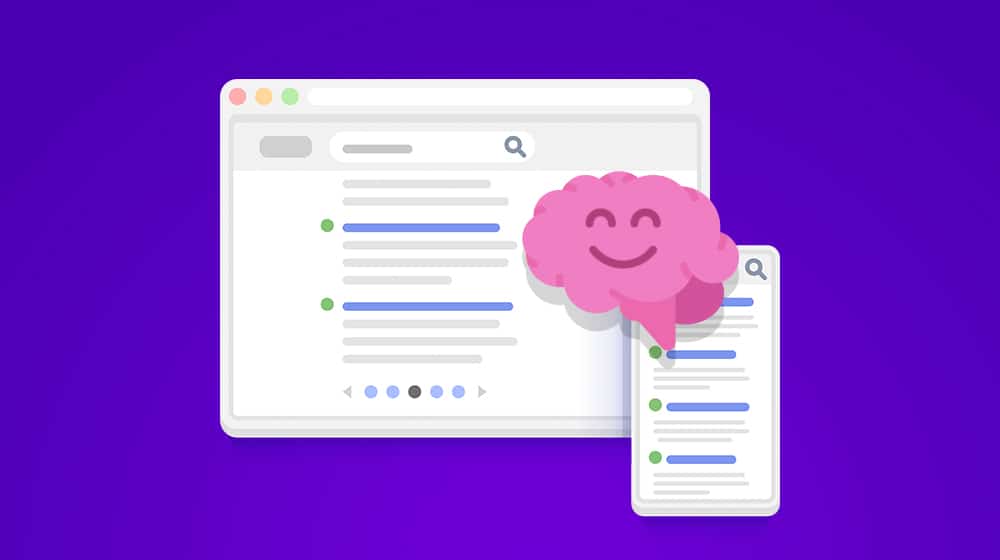
One of the many aspects of blogging I often mention is considering user intent. Intent optimization is an advanced marketing strategy that not many bloggers use, and it can kick your blogging up to the next level when you start.
What is it, though, and how can you start to use it?
 30 Second Summary
30 Second Summary
You need to understand user intent to create content that matches why people search. When someone types in a search query, they have one of five main goals: finding a specific website (navigational), learning about a topic (informational), following instructions (tutorial), comparing options (commercial) or making a purchase (transactional). If you match your content to these intents, you'll keep more visitors and turn them into customers.
What is User Intent?
User intent is all about the "why" behind a search query.
Every time someone goes to Google and types in something in that innocuous little search box, they have some reason to do so. Maybe they're looking for a product they want to buy. Perhaps they have a question they want to be answered, or they're researching a topic and have so little understanding of it that they're just looking for general information.
We as marketers talk about providing high-quality content that matches what our users want to see, but often when we talk about that, we launch into a discussion of search terms. And sure, keywords are essential, but it's also critical to know what's going on behind the keyword.
Let's take an example. There are many different possible results if a searcher types in "Dune Movie" (to date this post).
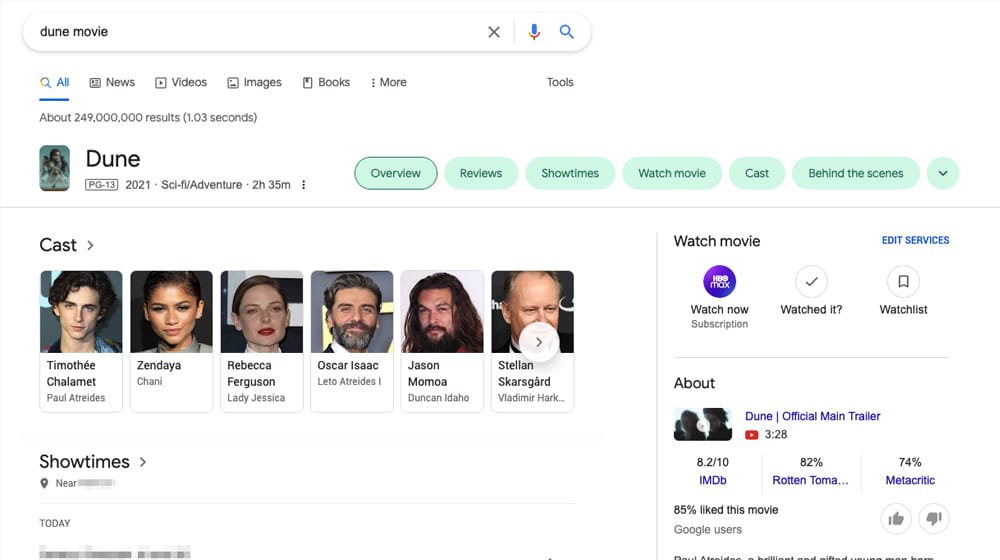
Which one is most useful depends on the user and what they want out of the search. Google tries to showcase as many as they can, which is why they have search results like:
- The cast of the movie.
- Showtimes near the user's location.
- Wiki/IMDB information, including ratings, synopsis, and where to stream it.
- Wikipedia pages for more general information.
- Video results with trailers, teasers, clips, and reviews.
- Social media posts and news stories about the movie
- The official website for the movie.
- Alternative search queries if these aren't what the user is looking for.
Why such a disparate variety of information? Google is trying to cover all of the bases for a generic query. If you were to refine that query, you'd see very different SERPs because the advanced query shows a stronger user intent.
- "Dune movie 1984" clarifies that the user wants to read about the older movie, not the new one.
- "Dune movie showtimes" makes it clear the user wants to know when the film is showing, so they can go see it.
- "Dune movie sequel" makes it clear the user wants to know if there's a second one in the works.
And so on. Google can then identify the intent behind the search (within reason) and provide more specific, aligned information to the user.
User intent often goes one step deeper than this, however. So far, all I've talked about is what Google does. The thing is, you need to know what Google does, so you can identify how to take advantage of it for your marketing strategy.
It's less applicable to a general query about a movie, so I picked a bad example for that one. There are already massive resources for every possible spin on a movie title query, so the chances of ranking for it are pretty slim. On the other hand, consider a search like:
"Benefits of fish oil"
Here, the user is searching for the benefits of a particular health supplement.
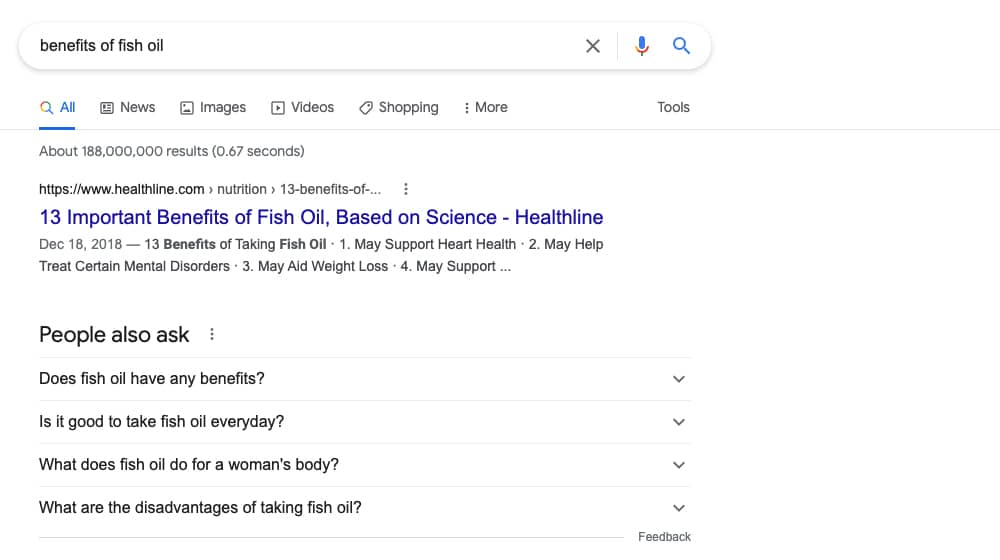
They have an informational search intent. They aren't looking for a site that's selling fish oil because they're still trying to determine if there are any benefits at all. They aren't looking for a place full of recipes that use fish because that's essentially off-topic. They're looking for information, usually with cited sources, from an authority they can trust.
What happens if you fail to satisfy user intent?
So, what happens if you write and optimize a blog post about a topic like, say, fish oil, but you don't cover the user's search intent?
Well, let me turn the question around on you. Say you're looking for information about a topic, and you search for it. The top result looks good, so you click on it. Browsing through the landing page, though, it doesn't seem applicable to your needs. You were looking for fish oil supplements, but what you found instead was an article about how oil spills affect fishing. (Unlikely, sure, but bear with me.) What do you do?
In most of these cases, probably 99% of them, you'd leave. The post doesn't include information relevant to what you wanted, so you don't stick around to read it.
I say 99% because some people will decide the topic is interesting enough and will stick around. However, most will leave to find a resource more in line with what they were originally looking for.
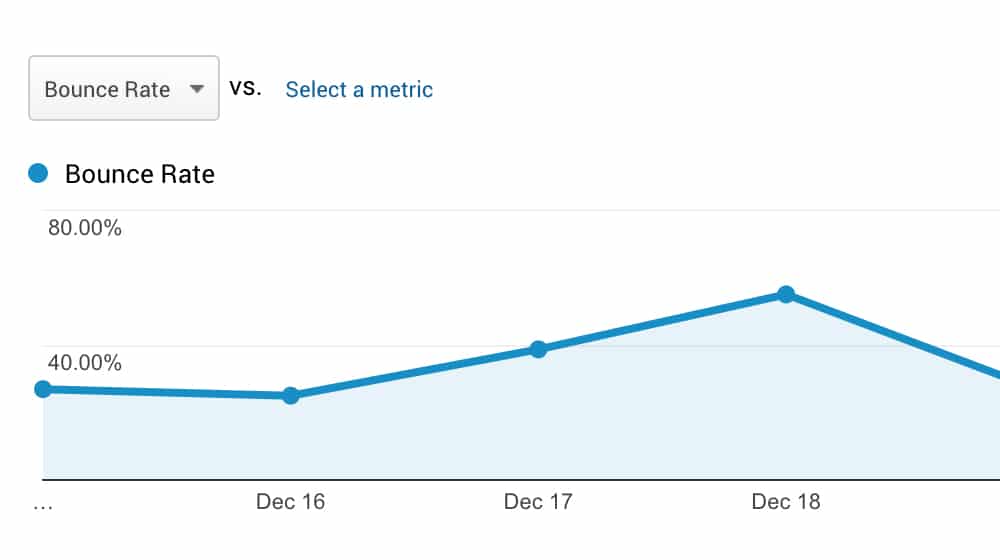
This situation isn't that detrimental if you're providing content for basic informational search intent, because in that case, you're not necessarily losing anything. However, if the search intent was more commercial, it means losing sales with lower conversion rates, hurting your user experience, reducing your click-through rate, and increasing your bounce rate. That's when an off-target content strategy can start to hurt your performance.
What Are The Different Types of User Intent?
Now let's talk about the different kinds of search intent. After all, people searching for things online can have very different reasons for exploring them.
Let's go with something like "alpine skis," for example:
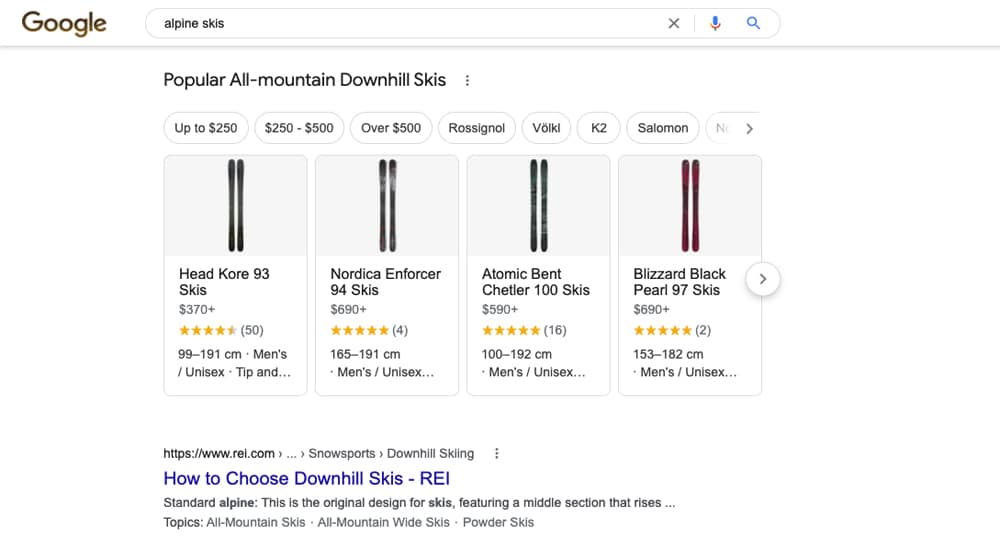
Someone searching for that keyword might have a very different intent:
- They may want to read about the design of alpine skis and learn how they're designed and how they differ from other kinds of skis.
- With sizing information, they could want to find out how to choose the right kind of alpine skis for them.
- They could want to buy alpine skis and thus find a store that sells them locally or online.
They might even just be looking for a ski brand named Alpine if one exists. All of these have different intents behind them, and they all need different kinds of content provided up-front. So, what are the different types of search intent? Most SEO pros identify four types.
Navigational search intent is among the most common and the least useful for 99% of websites out there. Yet, it's also a kind of search intent you absolutely cannot ignore. What does it mean, though?
Navigational search intent is search intent for a person that typically wants to visit a specific website. They want to navigate to their target. It's clearer in the example, though.
If a person types "Netflix" into a Google search, 90% of the time, they want to visit Netflix.com. Maybe some people would want to see news about Netflix or see their stock price or something else like that, but most people? They want to go to Netflix.
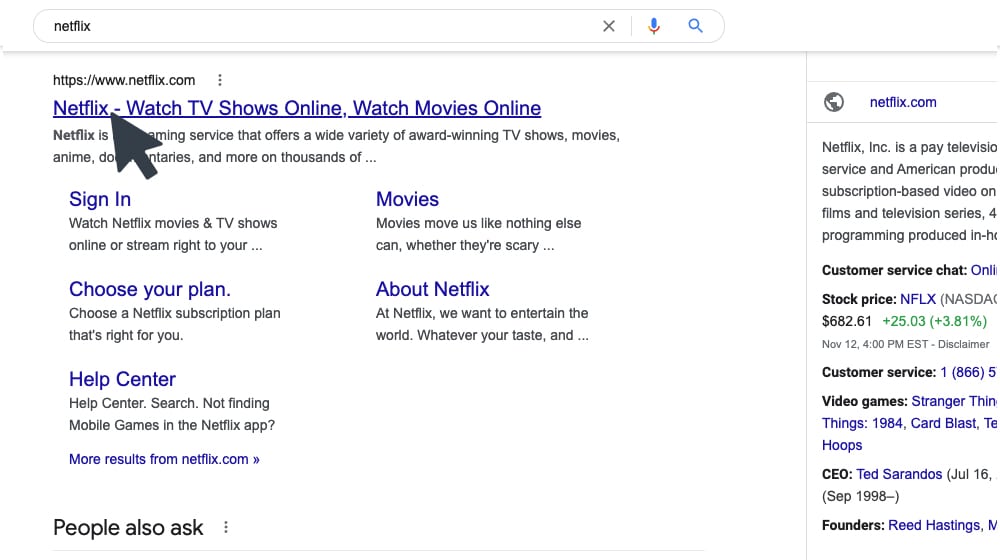
So, why don't they type Netflix.com into their navigation bar and go there directly? Why are navigational queries so common?
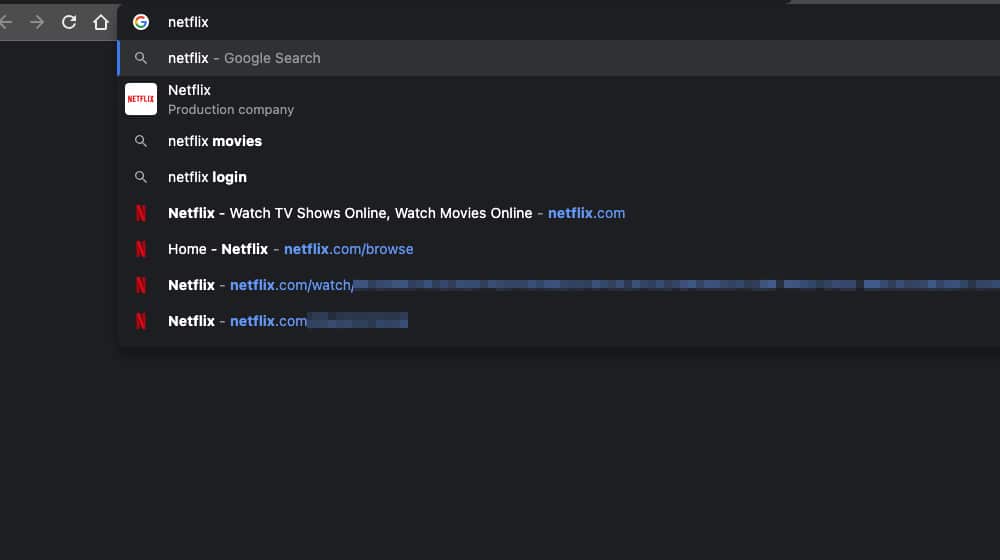
If you type something that's not a URL, it's the same as typing it into your favorite search engine. For the most popular web browsers, that's going to be either Google or Bing.
Combine this with a lower level of computer literacy amongst the average populace, and you can see how these queries are so popular. People know they can type Netflix in the bar, get taken to a Google page with many Netflix results, click on the Netflix.com result, and boom: they're at Netflix. They don't need to change their process to be more efficient and skip Google because their current process works, and why do they care they could save a millisecond?
In a way, it's even a slight benefit to security. If you accidentally type "neftlix" into your search bar, Google will assume you meant to go to Netflix and will provide you with the correct URL.
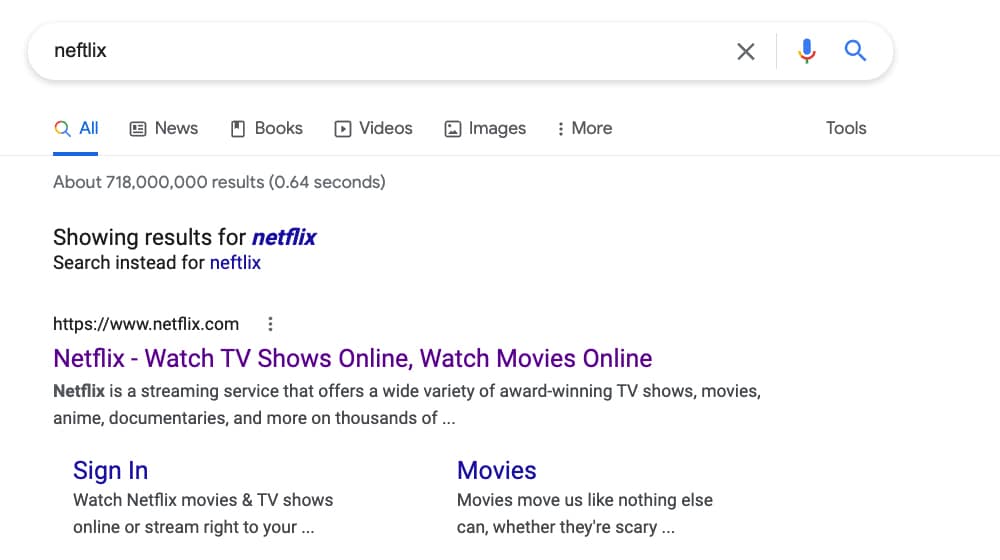
If you type neftlix.com into your bar and go directly to the URL… well, you still end up at Netflix because they own that domain. But, many businesses don't buy all the typo versions of their domains, and that's how phishing scammers take advantage of people.
The lesson here:
It's also why this isn't a helpful search intent for your blogging; you're never going to rank high enough for a navigational search that isn't for your brand. Just like you wouldn't want another brand out-ranking you for your own brand name, neither does anyone else want you out-ranking them for theirs. It's not necessarily worth trying since it's not what people were looking for, and it's in direct opposition with Google's algorithms.
2. Informational/Learning Search Intent
Informational or learning search intent is a user's search intent to read more information about their subject. It's for research above all else. 99% of the content on my blog, for example, is targeted for informational queries. I teach you how to do things and give you information about a topic, rather than trying to sell you on my services. But, that's a unique position I'm in; I don't need to put on a high-pressure sales pitch because my work is itself a sales pitch for what I do.
Informational intent is also widespread. Any time you search for something with the intent of learning (rather than navigating to a specific destination or buying a specific product), you're performing a specific search for informational content.
Typically, Google will understand informational intent queries and give you your result in the form of a featured snippet. For example, if you Google "what day is Christmas," you'll see a featured snippet above every search result that tells you "December 25".

Wikipedia is the top result for a massive array of informational intent queries. If you want general information about a subject, they're the most extensive resource for practically everything. However, they're just one site, so they only ever get one result in the search results. That leaves somewhere around nine more results on the first page for others to take up. And, unlike navigational searches, users with informational search intent are looking for various information. They are likely to browse the rest of the results and even click more than one or two of them.
Informational intent is a vast category and can cover everything from "the stages of a frog's life cycle" to "homemade tomato sauce recipes," which is why I like to divide it into two.
3. Tutorial/DIY Search Intent
Every authority on content marketing uses the same core resource for search intent: Google. Some time ago, Google wrote a post about search intent and how they use it, and they defined four kinds of search intent. The two above and the two below were their four; this one wasn't on it. That's because this one is a kind of informational intent. However, Google has since either moved or removed the post (I can't find it to even link to it now), and, anyway, it was information relevant to when they first started using search intent in their algorithm. Things are much more nuanced today.
I think of tutorial/instructive/DIY search intent as a kind of search intent. This type of intent is for users who aren't looking for general information but instead detailed instructions.
This type is distinct from transactional intent because they explicitly want to do something themselves and don't want to sell the finished product on that page.
Let's take something like "tomato sauce" as a query.
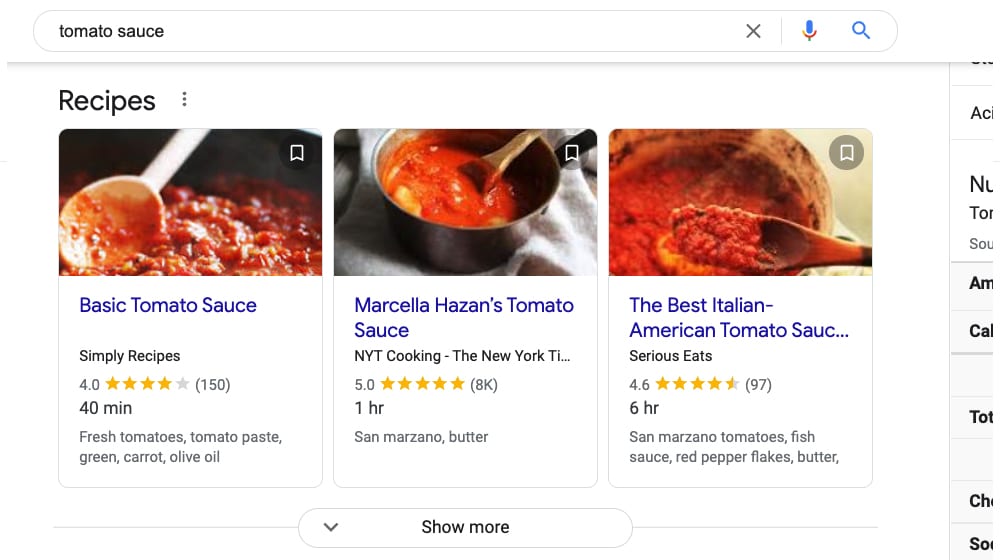
That query could have three equally valid results:
- The Wikipedia page for tomato sauce, describing the history of tomato sauces and their varieties.
- A Walmart or Amazon page selling tomato sauce in cans for you to purchase.
- A recipe site like Allrecipes or NYT Cooking provides a recipe to make tomato sauce yourself.
Among these, the first is informational, the second is transactional, and the third is tutorial.
Tutorial results are significant for a lot of small businesses, service providers, and other blogs. Many people take to the internet to discover how to do something, and when you provide them instructions, you fulfill their needs. You're essentially solving your visitor's pain points, and a percentage of those visitors will stick around and may even do business with you.
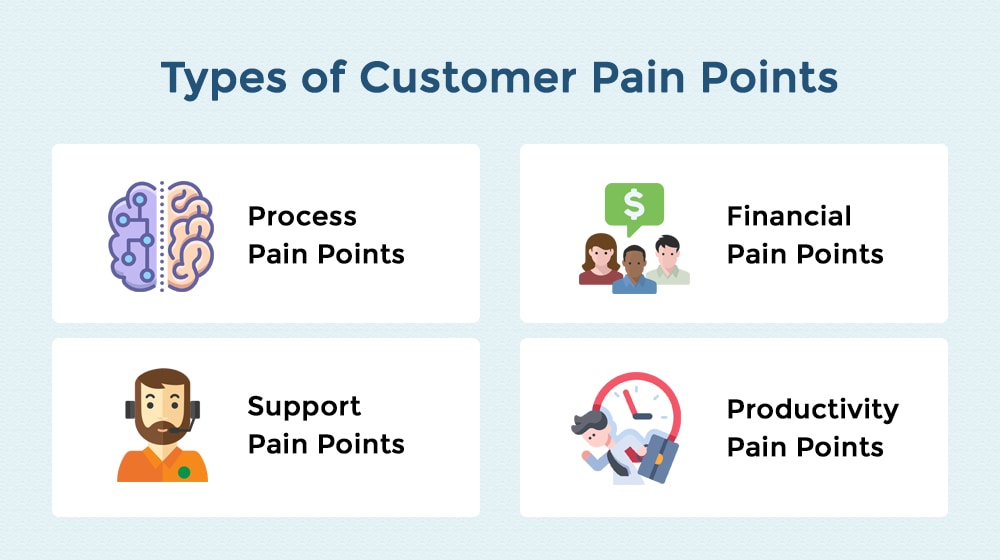
Moreover, you can convert tutorial search intent into transactional intent. When you write out how to do something, you can emphasize how much work it is and how much easier it would be if you just paid someone to do it for you. You're still satisfying user intent but giving them an alternative if they decide that it's not for them.
You see this a lot for complicated tasks (like digital marketing) or tasks with many risks involved. Something like repairing a laptop computer has a lot of risks inherent in opening up a small, fragile machine in a way that can break it more if you don't know what you're doing and can segue into a call to action for a computer repair company.
It covers all the bases and is the most flexible if you want to emphasize one over another.
4. Commercial/Consideration Search Intent
Commercial and transactional intent have been mentioned above, but I haven't gotten into them until now. These types of intent are very similar but can be thought of as different stages of a funnel.
Commercial/consideration intent is the funnel stage where a user knows they have a need and are looking for a product to fill it. However, they aren't yet ready to pull the trigger: they're doing research. For example, if someone is searching for a content marketing company, they might find my site. Still, they'll also look for my competitors to compare/contrast our services, prices, and other aspects that might influence their decision.
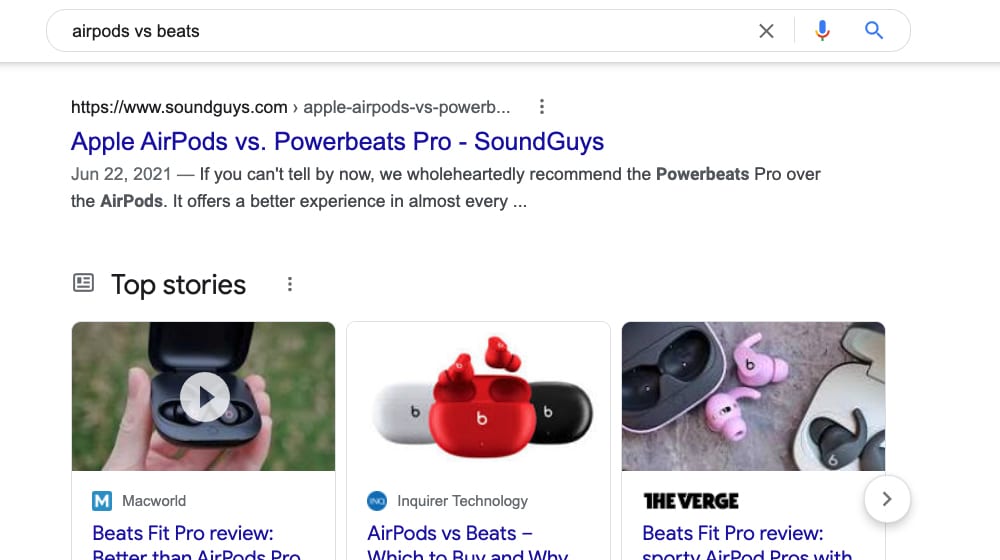
This area is also the space where a lot of affiliate sites live. All those sites that compare 5+ different products do the same thing, with charts and tables and links to buying those products on Amazon where the site makes some money? Those sites are taking advantage of commercial intent, and Wirecutter and Consumer Reports are significant players in that space.
5. Transactional/Purchase Search Intent
Transactional intent is, as you might have guessed, searches for when the user is ready to buy. They have their wallet in hand, and they're prepared to plug in those credit card numbers to get a product or service shipping to them.
Most of the time, this isn't its search. People will search with commercial/consideration intent and then find and bookmark, save, or otherwise transition to their chosen site to purchase without having to search for it again. These searches will typically yield eCommerce results with products.
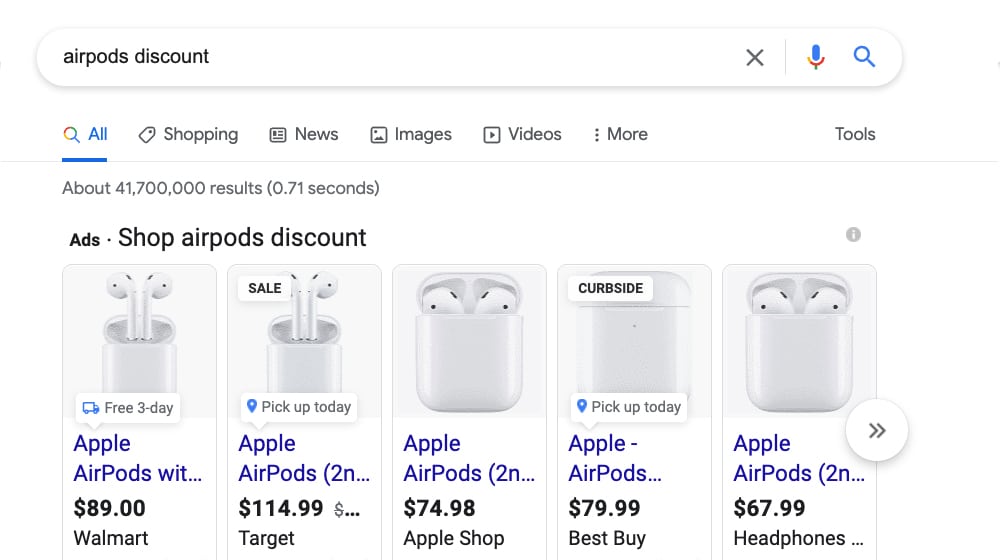
However, sometimes people will do a transactional search before they pull the trigger. They want to ensure they're getting the best price or that there aren't any coupons out there, whether that means looking at other search results or researching competing websites. Unfortunately for content marketers, Google Shopping does most of the heavy lifting here, and there's not much you can do beyond having a good product page.
How Can You Use User Intent?
Now that you know the core kinds of user intent, all that's left is making use of that information. So, how do you properly leverage user intent to your advantage?
It all comes down to a combination of research and intuition. Do your keyword research, and for each keyword, figure out the most likely user intent behind it. Some keywords are precise: "where to buy alpine skis" is pretty transactional, for example.
Others, like the "tomato sauce" example above, are open enough that you can either write one mega-post about it covering all the bases or, more reasonably, create 2-3 blog posts with the same keyword but different intents.
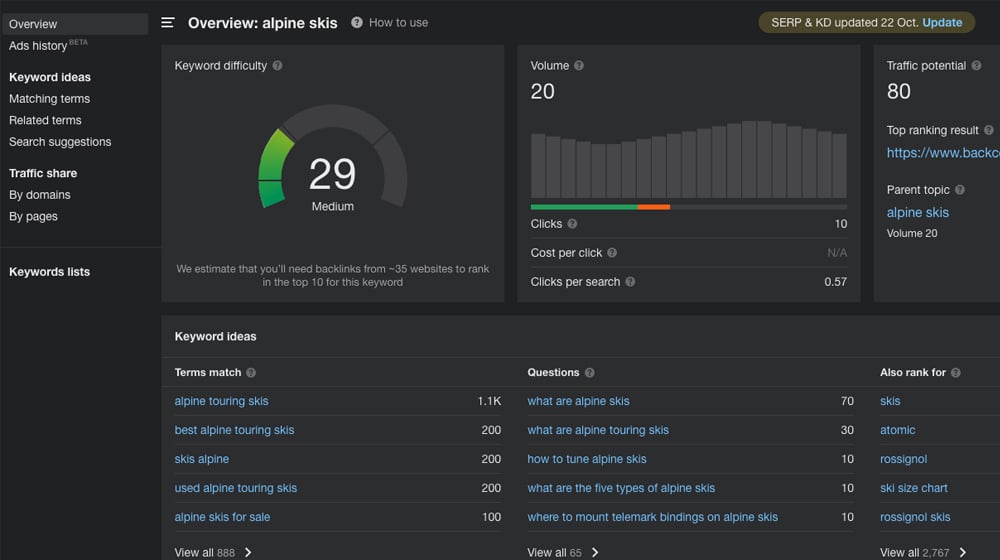
Intuition also comes into play when it comes time to decide where to focus your efforts. You can test after the fact to see which type of content is performing the best, but beforehand, there's not much way to know what will be successful.
For example:
- Who are they?
- What is their goal?
- What would you hope to accomplish with that search if you were in their shoes?
- How can you give them better information than the results that already exist?
- How can you engage with them and keep them around?
- How can you minimize fluff and maximize the amount of valuable information?
- How can you format and structure your post in a way that is easy to digest?
As you might have guessed, this blog post is mainly "informational intent." If I elaborated on it in another post, this last section here could be a tutorial intent post; I could write this same topic but with an entirely different intent. See how it goes?
Google Updates on User Intent in 2024
Google's updates in 2024 have been all about making your search experience easier and more intuitive - and user intent has been the focus of these updates.
Google now understands the different types of searches you might make. Whether you're buying something, looking for specific info, or just browsing, your search results will match what you want much better. You'll save time by not having to sift through unwanted results - that helps you find what you need faster and making your overall experience more pleasant.
The E-A-T principle, which stands for Expertise, Authoritativeness, and Trustworthiness, is a big focus in 2024. When you search for websites covering sensitive topics like health, money, and law (also known as Your Money or Your Life topics) - Google makes sure they are showing good information here. They built Google to give you accurate and trustworthy information and they want to avoid misinformation that can cause serious problems. The goal is to connect you with respected source. This also helps to build user confidence that they're reading good information from experts.
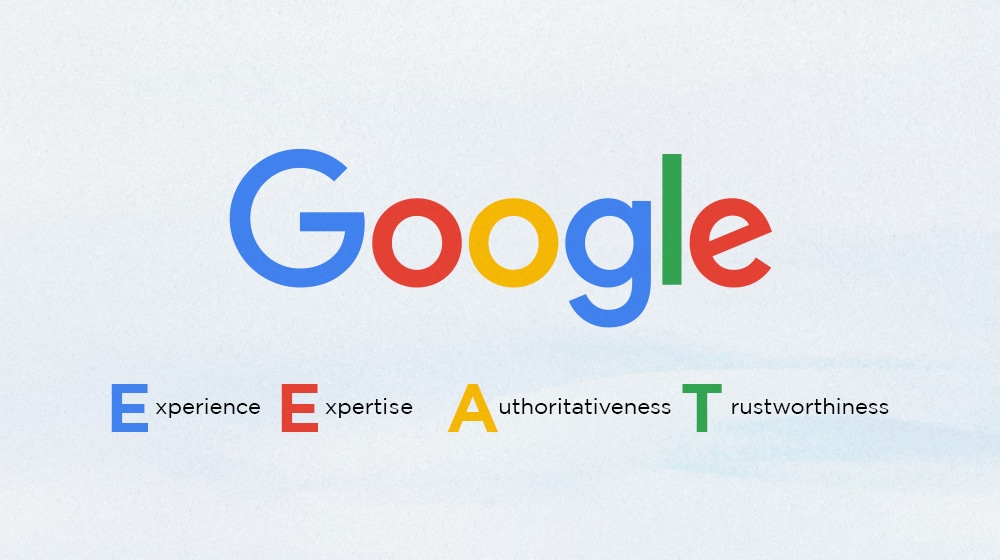
If you're in one of these YMYL industries and your site was hit, you might need to see how well you're matching the user intent behind the searches and if your EEAT can use optimization.
Content quality and relevance are going to be emphasized even more, too. Forget about keyword stuffing - Google doesn't care about that anymore. Now, its algorithms favor content that truly matches your needs. Well-written and powerful articles will most likely outperform poorly written ones. So, as a content creator, try writing with more depth and clarity. This makes your content stand out and be more helpful, and it can help you produce better quality content that people actually find useful. This is easier said than done. Everyone thinks they're writing quality content, right?
Also, watch out for spammy content. The March core update promises around a 45% drop in low-quality results - your search feed should clean up quite a bit. Google's helpful content system is now a main part of the core algorithm and checks websites more closely. It really gets general quality. This gives you better search experiences and improves your chances of finding handy and relevant content.
Mobile usability is still a big deal in 2024. With more mobile searches, sites need to be quick and responsive. Local searches have also become more fine-tuned. If you're looking for something nearby, you can expect more accurate results - even if you need to find something locally.
As a business, it's a good idea to change your SEO strategies sooner rather than later. You can create mobile-friendly content packed with helpful information, and make sure your content matches what people are looking for. These things make your site more helpful and ensures it keeps growing and providing a great experience. You'll stand out more and attract the right audience. That's all we want as marketers and website owners. Right?
If you have any questions about user search intent, please let me know. These are the advanced content marketing topics I love, and I'd be thrilled to get a great conversation going in the comments. Just drop me a line!



 30 Second Summary
30 Second Summary



January 13, 2022
This is a very interesting topic, James. User intent should really be one of the core things to consider when it comes to blogging.
January 19, 2022
Thanks, Rick! It's super important to say the least.
If your content isn't relevant to the topic/title then it's probably not a great article to begin with. I can see why Google puts so much emphasis on it.
March 27, 2022
Completely agree with this whole article! Trying to see and understand from a user's perspective is one of the best tips there is in blogging.
April 29, 2022
Thanks Jay!
April 27, 2022
Being able to anticipate possible user intents is extremely important. The types you listed here are some of the few bloggers should always anticipate.
April 29, 2022
Hi Ahmed, thanks for sharing!